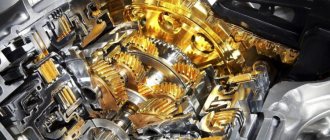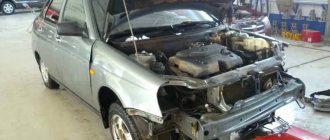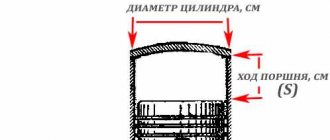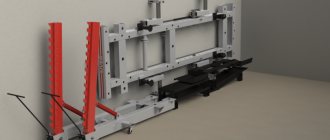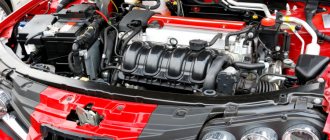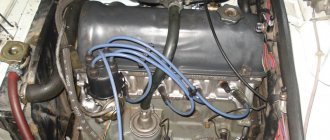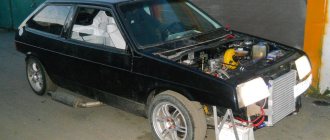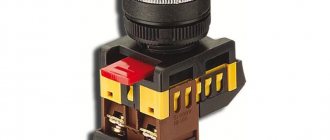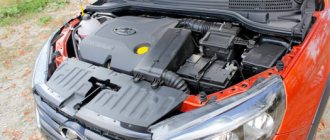To carry out the work, it is important not only to know what is included in an engine overhaul, but also how to prepare the engine and operate it after repair. It is first necessary to disassemble the internal combustion engine, clean it, assess the condition of the unit, and check all components. If the engine requires an overhaul, you should thoroughly prepare for the process, following the sequence of actions and recommendations of specialists.
What is a major overhaul
Overhaul is a set of repair work related to the replacement of parts that cannot be repaired (mainly pistons, rings, gaskets) and the repair of parts that can be restored to factory condition. After the overhaul, the engine is restored to its power performance indicators (power, compression, noiselessness and smooth operation). Unlike routine or unscheduled repairs (for example, the washer fuse blows or the heated rear window 2107 does not work), a major repair involves repairing the entire engine, and not individual parts. Therefore, this type of work costs a lot, requires experience, time and, preferably, a warm, well-lit garage if the driver wants to make capital with his own hands.
Since the engine is the heart of the vehicle, its repair must be carried out in compliance with all rules and regulations, accuracy and skill.
Reasons for increased engine wear
It is impossible to definitively establish what exactly led to engine wear, but there are several main reasons contributing to this.
- Untimely change of oil filter and oil. With use, especially if the mileage is significant, the oil loses many of its properties, and the operating conditions of engine parts worsen, which leads to their wear and, as a result, brings the period of major repairs closer.
- The use of low-quality oil brings the start of major repairs closer. Therefore, the choice of engine oil is very responsible, regardless of whether it is a foreign car or a VAZ. A major overhaul of a VAZ 2106 engine is not much different in content from repairing a foreign car engine; you should not skimp on such a component when operating VAZ family cars.
- Bad filters (fuel and air), as well as their untimely replacement, lead to abrasive particles entering the engine, causing premature wear and reducing the vehicle's mileage.
- The operating and storage conditions of the vehicle significantly influence the timing of repairs, including for VAZ vehicles. Increased ambient temperature and movement at maximum loads contribute to premature wear of the motor. At the same time, one launch in winter at a temperature of minus twenty degrees is equivalent, according to experts, to a run of one hundred to one hundred and fifty kilometers.
- Driving mode. If the main mileage of the car falls on highway driving, then engine wear will be significantly less than in urban conditions. According to experts, up to seventy percent of wear occurs at the time of start-up. So the “taxi” mode for any car, regardless of whether it is a VAZ or a foreign car, has a negative effect on the condition of the engine and brings the repair time closer.
When to overhaul an engine
Both gasoline and diesel engines burn out their resource after completing their allotted service life in engine hours (if the engine has been running for 1 hour, this is 1 engine hour) or mileage in thousands of kilometers.
If the following signs appear, it is necessary to overhaul the internal combustion engine:
- You have to add engine oil, it goes somewhere.
- Mechanical damage to the engine (crack in the block).
- Compression in the cylinders is below acceptable.
- Constant smoke from the muffler is blue or bluish (dark gray) thick and in large quantities.
- Knocks are heard (it could be the liner turning, etc.).
- The car doesn't pull as well as before, especially when going uphill.
- When checking the spark plugs, they are always dirty, with carbon deposits, and covered in oil.
- Fuel consumption has become higher than before.
- A lot of gases enter the crankcase.
- Low oil pressure in the system.
- The motor overheats under light loads.
- The engine runs intermittently.
These reasons do not necessarily indicate the need for a major overhaul of the internal combustion engine. If there are many such signs and they are repeated, then it’s time to trade in the car or do it yourself.
Based on the signs, they determine what kind of repair the engine requires:
- current or continuous repairs (repair or replacement of individual parts, for example, painting a bumper);
- technical repairs according to the schedule (repair or replacement of worn parts that have exhausted their service life);
- unscheduled repair of the internal combustion engine (this is when the service life has not yet expired, but for some reason the engine has broken down);
- major or major repairs, or capital repairs are done both according to schedule after a given service life, and after the final breakdown.
Our verdict
What's the result? Replacing the engine is a simpler and cheaper, and sometimes the only technically possible way to solve the problem. But if the engine initially has a poor reputation, say, at a certain point scuffs appear on the cylinders or the crankshaft may break, then replacement in this case will only delay the occurrence of the problem.
And it’s okay if you are replacing an engine with a mileage of half a million kilometers for a much more recent one, which has “run” a hundred thousand. What if you exchange an awl for soap? A major overhaul will not save either time or money. In general, this is not a question about economic feasibility, but about further reliability and service life, since “capital” can breathe a second life into an old engine. But only on condition that the repairs are carried out at the proper level. No confidence in the performers? Then it’s better to immediately choose the replacement option!
Need spare parts? Look for them in our ad database!
What is the engine mileage before major overhaul?
The mileage life of an average car is considered to be about 200 thousand km, after which its characteristics decrease and it’s time to invest in some capital. There are cars with a lifespan of 1 million km (million-dollar engines are called), although now there are rumors that the lifespan of new expensive cars, which used to be million-dollar, now have a much shorter lifespan. The more often a car is repaired, the more financially profitable it is for auto manufacturers and auto parts stores, but this spoils the reputation of a brand or a specific car model.
In some cases, with severe wear of the internal combustion engine or severe breakdowns, it is more advisable to do an engine swap.
The manufacturer AvtoVAZ has set the average mileage for VAZ 2114 cars = 150 thousand km. On average, all Russian cars have the same indicators. But, if various problems are corrected in a timely manner, the engine life can easily withstand 250 thousand km. The service life of foreign car engines is, on average, 200,000 - 300,000 km before overhaul.
What are the reasons for increased engine wear?
As with other questions, there is no clear answer here. It is quite difficult to determine what led to engine wear. Despite this, there are a considerable number of reasons that have a great influence on engine wear.
- Untimely replacement of oil system elements. Over time, oils lose their consumer parameters, the operating conditions of engine friction elements deteriorate significantly, as a result, this will lead to wear of these parts. Replacing the oil filter with oil is an important and integral part of regular vehicle maintenance.
- When selecting motor oils, it is worth keeping in mind that cheap and low-quality products “help” to hasten the start of major repair work. Do not forget that the overhaul of a Soviet-made VAZ engine is no different from the repair of foreign car engines. Therefore, even if you own a VAZ car, you should buy only high-quality and proven oils.
- Untimely replacement of fuel and air filters also harms engines.
- An important factor is the operating conditions. Driving at high speeds will shorten the vehicle's mileage. Elevated air temperatures also have a detrimental effect on the car engine. Expert estimates also showed that one engine start in severe frost of twenty degrees is equivalent to approximately 150 kilometers.
- A rather serious aspect is the driving mode. As is correct, driving on the highway exposes the car to the least amount of stress. Experts agreed that seventy percent of wear comes from engine starting. For this reason, taxi work will have a negative impact on any engine and will only speed up the time of repair work.
What is included in an engine overhaul?
Overhaul of diesel and gasoline engines is done in stages:
- Disassembling the internal combustion engine.
- Parts washing and cleaning.
- After cleaning, an experienced auto mechanic is able to determine how badly certain parts are worn and whether they can be repaired or better replaced. They do troubleshooting, that is, after the cylinder head (cylinder head) has been removed, it and the cylinder block (cylinder head) are checked for chips and cracks; examine the cylinders for scuffs and scratches; determine the gaps of mating parts; inspect the condition of the pistons for the presence of chips, shells, carbon deposits; inspect the crankshaft connecting rods; study of the internal combustion engine crankshaft; fingers; bearings; parts of the gas distribution mechanism are also checked (valves, rocker arms, etc.). They also compare the dimensions of important parts with the factory ones.
- After troubleshooting, it is necessary to assess the degree of wear of the entire engine: what to change, what to leave, what to repair.
Tips for repairing internal combustion engines
- If you have never had to completely disassemble an engine, then it would be more correct and better to invite a friend who understands it.
- It is advisable to carry out disassembly in a warm and well-lit garage.
- During disassembly, place all bolts, washers and nuts in a box with partitions, do not throw everything in one bucket.
- During disassembly, remember the sequence if you are doing this for the first time.
- If you don’t know what the spare parts are called, take the old parts to the store and show them to the seller.
Dismantling and disassembly
Depending on the make and model of the car (engine design, number of cylinders, type of gearbox), the engine removal process may vary. The engine location on front-wheel drive and rear-wheel drive is also different.
Carburetor engines are much easier and faster to disassemble, since they are not stuffed with electronic devices, in the presence of which, in order to get to the engine itself, you have to carefully dismantle them all.
So, if you have to capitalize Kamaz, for example, then its diesel engine from the Yaroslavl YaMZ-236 plant will take about 10 hours to dismantle. If you do the same work with heavy-duty Kamaz analogues, it will take more than 30 hours.
And to disassemble a VAZ engine, it takes about 3 hours. And the engines of foreign passenger cars will take about 10 hours.
It is necessary to disassemble slowly, throwing bolts and nuts anywhere. With disassembly, diagnostics, so to speak, have already begun.
What alternatives to engine overhaul exist?
The issue of alternative methods of car restoration is incredibly relevant. People do not want to spend huge amounts of money and carry out major repairs to the unit. Even good capital does not guarantee that the engine will operate for another 100,000 km without problems. The search for alternative options is especially relevant for owners of foreign cars in which the cost of repairs is off the charts. You can pay attention to the following options for your situation:
- Purchasing an assembled engine part and performing a complete replacement. In this case, you will not have to pay for diagnostics, repair work, or troubleshooting. It is enough to pay for a replacement unit, which will cost less.
- Search for a contract engine. For Japanese and American cars, the search for engines imported from other countries is relevant. You can buy a practically new engine for little money.
- Selling a car or exchanging for another car. If there is no money for repairs, you can sell the car by explaining the engine problems to the new owner. For the money you earn, you can buy a simpler car.
- Exchange a faulty engine for a working one at a showroom that deals with your brand of car. Here you can often find quite decent engine options with a small surcharge.
- Purchasing parts for repairs at disassembly. This is not the best option, but if there are no other options, it is worth using it. The savings will be noticeable.
Defects of elements during internal combustion engine capitalization
The defect in this case is mechanical, that is, it is necessary to check visually and with the help of measuring instruments the wear of parts.
Troubleshooting of internal combustion engines includes the following work:
- inspect the crankshaft and measure its dimensions, check for bends and alignment;
- inspect the cylinder block body (BC);
- check the parts of the connecting rod and crank mechanism for play and the condition itself: pistons, cylinders, rings, pins, connecting rods;
- inspect the cylinder head housing (cylinder head);
- gas distribution mechanism parts;
- determine the maintainability of parts and assemblies.
What spare parts are needed for engine overhaul?
After completing the troubleshooting procedure and sifting out those that are suitable for restoration and those that are not, you need to order new parts to replace the unusable ones. When you already know what spare parts are needed, you don’t need to delay ordering and purchasing them, since new parts still need to be prepared for installation.
Spare parts for overhauls for gasoline engines:
- Liners (main and connecting rod).
- Piston group parts.
- Connecting rod pins.
- Connecting rod bushings.
- Valves (all, both intake and exhaust).
- Oil scraper rings.
- Gaskets (full set).
- Valve guides and seats.
- Pump with repair kit.
- Oil filter and pump.
- Other related details.
Grinding the block and crankshaft
After the issue with spare parts has been resolved, they begin to repair and restore the block and crankshaft of the internal combustion engine. Using a milling and surface grinding machine, the layer of the seat of the cylinder head and the block itself is removed until there are no shells or chips left. It happens that there are several deep shells, due to which you have to remove the layers in several passes. Usually, depending on the degree of damage, layers of 1 mm, 0.5 mm, 0.25 mm, 0.1 mm, 0.05 mm thick are cut off. After this, they begin to grind the surface to a mirror shine.
For crankshaft grinding, there is a special table that shows the thickness and efficiency values after repair compared to a new factory one.
| Type of repair | Thickness, mm | Efficiency compared to new |
| Repair No. 1 | 0,25 | 80-90% |
| Repair No. 2 | 0,50 | 70-75% |
| Repair No. 3 | 0,75 | 65-70% |
| Repair No. 4 | 1,00 | 50-55% |
| Repair No. 5 | 1,25 | 40-45% |
| Repair No. 6 | 1,50 | Less than 30% |
| Repair No. 7 | 2,00 | Not applicable since 1995 |
Repair of the block head (cylinder head of the internal combustion engine)
Although it is not difficult to carry out repair work on the cylinder head, for some reason many people try to send it to a service center.
Repair of the block head consists of the following types of work:
- We replace the camshaft (all that is in this engine).
- We change the suction and exhaust valves.
- We change the guide bushings.
- We change valve stem seals and seats.
- If there are cracks in the cylinder head, then we either change the head and grind it again, or weld these cracks with argon.
Assembly and installation of internal combustion engines
Sequence of engine assembly after major overhaul:
- Install the half-shaft bearings and seat the crankshaft.
- Install connecting rods and piston group parts.
- Correctly install and tighten the yokes (arc-shaped crankshaft mounting).
- Install the gaskets correctly, check that the gasket does not cover the channel holes.
- Installation of covers covering the motor.
- Install the oil pump and water pump.
- Install the engine crankshaft pulley. We have already learned how to remove the crankshaft pulley.
- Install the cylinder head.
- Install the pan, crankcase.
- Collect small knots.
If you decide to make a capital with your own hands for the first time, after all the work before assembly, it is better to carry out the assembly with an experienced specialist in this matter. The lifespan of the entire car depends on the quality of the assembly.
What is its essence?
Engine overhaul is a set of repair work on the power unit in order to restore its original (factory) characteristics. Do not confuse overhaul with engine overhaul. During a major overhaul, a large number of worn parts are replaced. Overhaul is the disassembly and reassembly of a unit when repairing an engine.
In this case, only a small part of the parts has to be changed, so this is far from a major engine overhaul. Or, for example, the mechanics of a drowned motor are in good working order (the mileage is low), but it cannot be started without a bulkhead, otherwise a water hammer will occur.
Run-in after capital
The most enjoyable process in such work is the necessary running-in for the engine with new parts. During break-in, new parts are ground in, so it is not recommended to immediately apply a large load. It is recommended to run-in for up to 2000 km without jerks or sudden starts.
There are several break-in methods:
- Running in cold on a stand.
- Cold running without a stand. This method is common, especially in the CIS countries. After preparing everything necessary (engine oil and coolant are filled in), without starting the engine, tow the car at speed 3 for 2 hours. This method is not recommended. By the way, a very important reminder: motor oil has a code and symbols for additives; before purchasing it, it is advisable to learn how to decipher the markings of motor oils, after which you can make the right choice yourself.
- Hot running. This method involves starting the engine and letting it idle for 3 minutes, then turning off the engine. And they do this several times, only waiting for the engine to cool down. Then, after short starts, start the engine and let it run for 1 hour. During break-in, the engine is inspected for leaks and other indicators. After running in, adjust the valve clearances and set the desired ignition. If contact ignition is installed, it is recommended to install electronic ignition instead of the old one. It reduces fuel consumption and generates high voltage up to 24 kilovolts, while contact ignition can supply no more than 18 kilovolts to the spark plug. Thanks to this, even dirty spark plugs produce a spark.
- Natural run-in. It is run in under the following conditions: smooth ride, speed no more than 60 km. After overhaul without installing new liners, running-in is carried out up to 2 thousand km. If new liners were installed, then 4 thousand km.
Many people recommend breaking in only when cold, but some experts recommend breaking in both cold and hot.
Abroad, they say, car service centers have run-in and test benches for internal combustion engines. Using special electronics, this stand shows the service life of a restored engine.
If you decide not to do the overhaul yourself, but to send it to a service center, you will receive a guarantee for the repaired motor. The guarantee is given depending on how you choose, some for 20 thousand km, others for 30 thousand km. mileage
Tips and tricks
As already mentioned, the service life of an internal combustion engine before overhaul depends on many factors. In order to delay major engine repairs, it is necessary to pay special attention to the quality and correct selection of engine oil in relation to a specific type of engine, and promptly change the air, oil and fuel filters. Also, the power unit must be able to operate correctly, avoiding constant peak loads and tight driving. It is equally important to monitor the condition of the engine, quickly eliminate problems that arise, and carry out preventive procedures.
- The main reason for rapid engine failure is oil changes, which are not carried out according to regulations. Increasing the replacement interval, taking into account the low quality of fuel and dusty roads in the CIS, leads to the fact that the engine ultimately runs on lubricant that has oxidized and lost its properties. Dust and deposits also enter the unit through clogged filters. As a result, the associated rubbing parts begin to work under conditions of increased wear, the channels of the lubrication system become coked, the power system suffers, etc.
Let us add that clogged filters can not only allow dirt into the engine, but also significantly affect the composition of the fuel-air mixture in modern engines with injectors. In this case, the quality of fuel atomization deteriorates, the power of the internal combustion engine decreases, and local overheating occurs. This also includes driving on low-quality fuel or with an inappropriate octane/cetane number, since detonation can quickly destroy a previously serviceable engine.In order to avoid burnout or melting of pistons, burnout of valves and other troubles, you need to not only change filters and oil according to the regulations, but also fill in high-quality fuel, and also periodically clean the injector every 30-40 thousand km.
- As for the oil itself, its viscosity changes with mileage, and the additive package stops working effectively after 10 thousand kilometers traveled. For this reason, any lubricant (even high-quality synthetics) when driving on domestic fuel should be changed no later than the indicated mark. It is also very important to select the correct engine oil, taking into account the vehicle manufacturer’s tolerances. Another problem is the large number of counterfeits on the modern fuel and lubricants market. Counterfeit motor oil does not contain a package of branded additives, and is also very often the cheapest “mineral oil”, which is bottled into containers for expensive synthetics or semi-synthetics of famous brands. The logical result is that deposits accumulate in the engine and parts wear out very quickly, especially on forced turbo engines. In some cases, rapid blockage of the lubrication system channels occurs, oil starvation occurs, and scoring occurs. A particularly dangerous outcome of driving on low-grade oil can be jamming of the power unit. Note that in such cases, many car enthusiasts rightly think about a contract engine, since the existing one may be in a state where its overhaul is impractical.
- Another factor that affects the service life of the engine before overhaul is the proper operation of the internal combustion engine systems and mechanisms, as well as their correct settings. For example, problems with timing phases due to an incorrectly installed belt can lead to dire consequences over time. The appearance of engine tripping as a result of breakdowns of individual elements of the ignition system, incorrect adjustment of the said system (incorrectly set ignition timing), too “cold” or “hot” spark plugs can also be the reasons for the accelerated failure of the entire internal combustion engine. In order to avoid serious consequences, any changes in the operation of the motor should be a reason for its diagnosis in order to quickly eliminate the failure or malfunction that has occurred.
- The appearance of extraneous sounds while the engine is running is also an alarming symptom. Knock of valves and hydraulic compensators, camshaft, crankshaft, connecting rod knock, knock of piston pins or pistons themselves, as well as other extraneous sounds are a sign that the car needs to be taken to a service center. Sometimes driving under your own power with a knocking engine is not recommended, and in some cases it is completely prohibited.
- The temperature regime in which the power unit is operated also has a huge impact on the life of the motor. Overheating of the entire engine and local overheating can lead to deformation of the cylinder head, burnout of the cylinder head gasket, and failure of various parts and components. Cases where antifreeze gradually enters the engine oil are considered dangerous, diluting the lubricant and deteriorating the properties of the material. For this reason, it is necessary to constantly monitor the condition of the engine cooling system.
